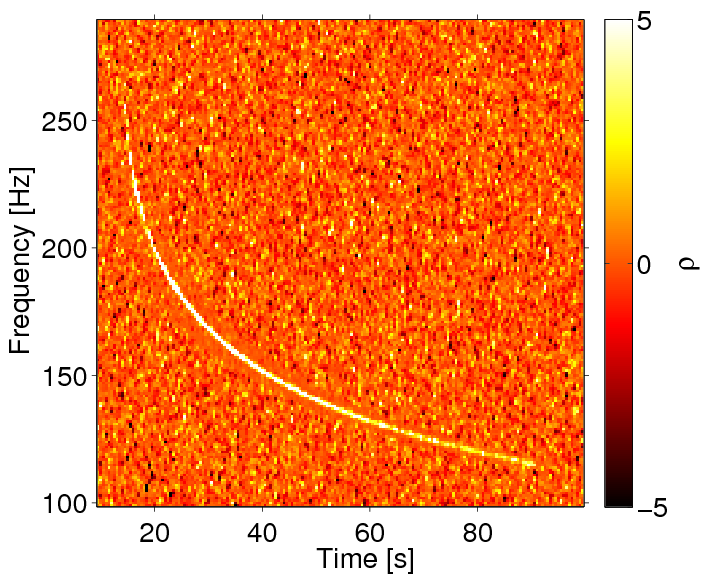A lot of work has been carried out by scientists searching for gravitational waves (GWs) with the LIGO and Virgo detectors. So far, the focus either has been on short GW signals, lasting a few tenths of a second or less, or on very long-lasting GW signals, which persist indefinitely. But what about “intermediate” GW signals which fall in between these two extremes? This is the question that a new search pipeline for “long-lasting transient” GWs with durations between 10 and 500 seconds is trying to answer.
Sources of long-lasting transient gravitational waves
Part of the reason why long-lasting transient GW signals have not previously received much attention is that there are not as many theoretical models which predict them compared to other types of GW signals. However, there are still a few models which predict GW signals with durations in this intermediate range; most of these models are associated with things that happen after the core of a star collapses and potentially explodes in a supernova.
Depending on the mass of the original star, it will either form a black hole or a neutron star after its core collapses. More massive stars end up as black holes, and sometimes, the resulting black hole will be surrounded by an accretion disk of orbiting gas. Certain types of instabilities in the accretion disk may cause it to become rather clumpy and asymmetric, creating conditions in which GWs could be produced as the clumps inspiral into the central black hole. However, less massive stars will collapse to form neutron stars, which often rotate very rapidly and can become deformed and asymmetric due to strong magnetic fields or internal instabilities. As the neutron star rotates, it can often produce long-lasting transient GW signals.
Description of the search pipeline
We used data that the two LIGO interferometers – H1 (in Hanford, WA) and L1 (in Livingston, LA) – collected during the “S5” and “S6” science runs, which ran from 2005 to 2007, and from 2009 to 2010, respectively. We look at all of the data we can and search for GWs coming from all directions; an “all-sky” search like this is important because it allows us to look for GWs which may be produced by unknown or unmodeled mechanisms. Even though we have some predictions for astrophysical phenomena which should produce long-lasting GWs, the actual signature, or “waveform” is not well-known in most cases. Because of this, we use a coherent “excess power” method. Coherent means that we use data from multiple detectors (two in this case); a real GW signal should be present and look similar in all of the detectors. In an excess power (or “unmodeled”) search, we look through the data and try to find anything that deposits significant power in the detectors.
To perform this analysis, we take calibrated data from the detectors and make spectrograms, like the one shown on the right, which includes a simulated GW signal (visible as a bright, downward-curving track). We then use a clustering algorithm to pick out groups of pixels which “stand out” and may correspond to a GW signal. To test our search pipeline, we added many different simulations of GW signals to the data, and then checked whether we were able to detect them. Some of the simulated GW signals look like the one shown in the figure, while others may look more like blobs or lines – because our search is unmodeled and all-sky, we don’t know exactly what to expect!

A plot showing a spectrogram (also known as an ft-map) of GW signal-to-noise ratio (rho). The color scale indicates the relative strength of the signal. Time is shown on the x-axis and frequency is shown on the y-axis. A simulated GW signal is included in the data and is visible as a bright, downward-curving track. In this search, a clustering algorithm would try to pick out this track and identify it as a GW signal.
Search results and future work
This search did not detect any gravitational waves in the LIGO data collected between 2005 and 2010, however, we can still make scientific statements about how often long-lasting transient GWs should occur. Our results estimate the maximum number of long-lasting transient GWs which pass by Earth per year as a function of signal strength; at 90% confidence, we project that there are fewer than two strong signals passing by Earth per year.
We are currently working to improve the search by making it sensitive to signals with longer durations and adding new features to the clustering algorithm. The Advanced LIGO detectors have recently begun taking data; eventually, they are expected to be 10 times more sensitive than they were during S5 and S6. The improvements to the search pipeline, coupled with the increased sensitivity of the Advanced LIGO detectors, should drastically improve the probability of detecting long-lasting transient GWs – paving the way for an exciting future in GW astronomy.

